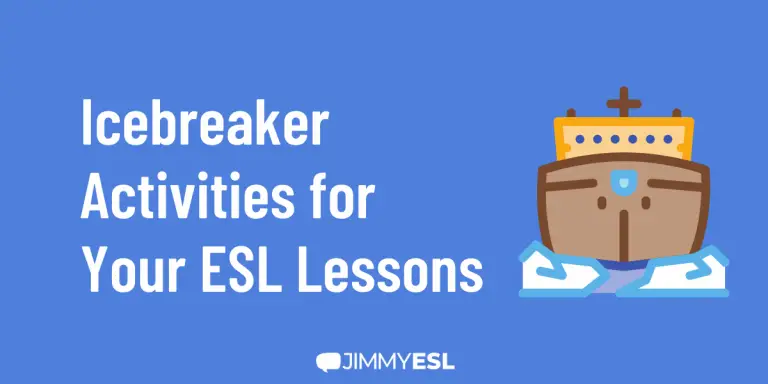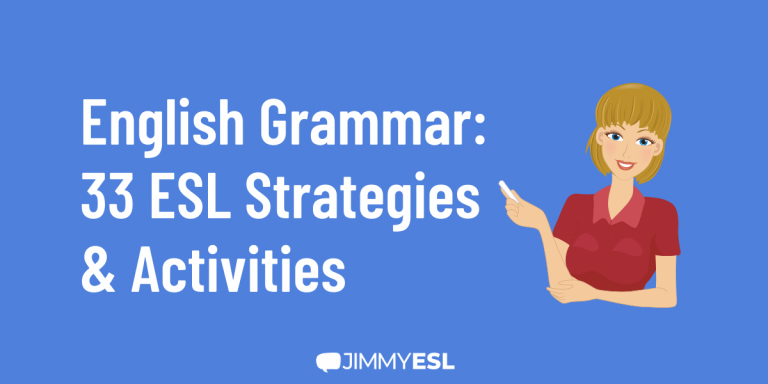Fun ESL Warm Up Activities & Games for Adults & Kids
If you teach ESL, then you probably use ESL warm up games.
While newer teachers often struggle to find warm ups for English class that are compelling enough for students, veteran teachers may burn out on using the same ESL warm ups over and over in class.
No matter which category you fall into, you could probably benefit from some new, interesting ESL warm up activities for your class.
Dive into this resource full of ESL warm up activities for adults and children alike.
Why do Warm Ups for ESL Students Matter?
ESL warm up games and activities are simply an activity that you do for 5-10 minutes at the beginning of class to help your students get situated and in the right mindset for English class.
ESL warm up activities for intermediate students, advanced students, and beginners matter because they set the tone for class and increase students’ confidence.
It may seem like ESL warm up exercises aren’t as important as other parts of your lesson, but in fact they’re crucial to helping your students get comfortable with being in your class and speaking English.
Whether you’re teaching students or adults, a large class or just one student, the right warm up activities can make your students feel more comfortable and confident, and they can also make your class seem more fun.
8 Fun ESL Warm Up Activities & Games
Here are our 8 favorite ESL warm up activities for adults and kids as well:
1. Twenty Questions
- Student level: All levels
- Type of lesson: group or individual
This classic game involves either the teacher or an appointed student thinking of something, and then the class gets to ask 20 yes or no questions to determine what it is they’re thinking of.
Participants are also traditionally allowed to ask whether the item in question is an “animal, vegetable, or mineral” to help narrow down the field of possibilities. Pretty much any object that’s not an animal or plant is a mineral.
Students might ask questions like “Is it bigger than a breadbox?” “Is it furry?” “Does it live in the water?” “Do they go to this school?” to figure out the answer.
This game gives students the chance to test out tons of vocabulary, and it also helps them practice both speaking and listening skills.
2. I Spy
- Student level: Beginner to Intermediate
- Type of lesson: group or individual
In this game, one person thinks of something that they can see in the classroom. For example, maybe they choose the clock.
In a digital classroom, the “spyer” might think of something they can see on the screen or something they can see in the background of the student’s video.
Then, they give everyone hints about what it is they’re thinking of without giving the object away. So, they might say, “I spy something black and white,” or “I spy something with two hands.”
Everyone tries to guess the object that they’re thinking of, and whoever guesses correctly becomes the “spyer” next round.
This game is best for beginner to intermediate students because it provides ample opportunity to use vocabulary like colors, shapes, numbers, sizes, and locations.
3. Categories
- Student level: All levels
- Type of lesson: group or individual
This game is a spin off the board game Scattergories, but with a fun twist!
Instead of having prescribed categories, your students can come up with own categories. Categories for younger students could include animals, nouns, emotions, names, foods, weather, or clothing.
Advanced students could use categories pertinent to the unit they’re studying or more general categories like modes of transportation, things you find at the park, or past tense verbs.
The class will come up with 6 categories and each student writes the categories down on a piece of paper. Then the teacher chooses a random letter (you can find an online random letter generator here).
The teacher then sets a timer for 2 minutes and students think of as many words in each category starting with the letter in question in that time.
For example, if the letter was B and one of the categories was animals, a student might write down Bear, Bee, Bird, Beetle, Barracuda, Banana Slug, et cetera.
Once the time is up, students read their words out loud. If two students have the same word, both have to cross theirs out (you can omit this rule for younger students). Students get points for each unique word they have.
You can also play this game in teams with larger class sizes, and it’s easy to play in an online lesson, too.
4. The Alphabet Game
- Student level: Beginner to Intermediate
- Type of lesson: group or individual
In this game, you choose a category (like places, animals, food, or names).
You’ll go around the class and each student will have to name an item in the given category that starts with a certain letter, going in alphabetical order.
So if the category was food, student A might say Apples, student B Bananas, Student C Cheese, and so on.
Letters like Q and Z can be stumpers for younger students, so you can allow collaboration if someone is struggling to come up with a word for their letter.
This game is easily adaptable for all levels of learners.
More activities and games for your ESL lessons
5. Hangman
- Student level: Beginner to Intermediate
- Type of lesson: group or individual
This ESL warm up activity is a classic for a reason.
If you don’t know the rules of hangman, they’re simple: the teacher (or an appointed student) draws a “gallows” on the board (or in an online portal) and creates dotted lines for each letter in the word they’ve chosen below, like so:
Students then guess which letters are in the word. Wrong guesses result in another part of the “hangman” being drawn, while right guesses get filled in on the board, like this:
If the students correctly guess the word, they win. If the teacher finishes drawing the hangman before they guess, then they lose.
Hangman is a great game because you can easily adapt how hard or easy it is depending on which word you choose.
And you can also use it to review vocabulary words from your lesson!
6. Word Morph
- Student level: Intermediate to Advanced
- Type of lesson: group or individual
In this simple word game, the teacher thinks of one word (probably a relatively simple 4-5 letter word, like “bake”), and then students change one letter at a time to create new words.
An example of this would be BAKE-BIKE-BITE-SITE-SIDE-HIDE-HIRE-HARE-HARD-CARD.
Write the words on the whiteboard or in your interactive online portal.
You can make this game more challenging and fun by trying to get the longest chain possible or having students try to circle back to the original word, changing every letter and never repeating any words.
This game is perfect for intermediate students.
7. The Adjective Game
- Student level: Intermediate to Advanced
- Type of lesson: group or individual
You can play this game with a ball, though you can also just go around in a circle if you don’t have a ball.
If you’re teaching online, you can simply go back and forth if you’re one-on-one. If you’re in a small group, each student can choose another to go after their turn.
The teacher will think of a person, animal, or thing and share it with the class.
The students will then pass the ball to one another – if the ball lands on a student, they need to think of a new adjective to describe the thing. If the student draws a blank or repeats an adjective that’s already been said, they’re out.
For example, the teacher might use “dog” as their noun. The students would go around saying descriptors like furry, four-legged, friendly, alive, smelly, and so on.
This game is adaptable and fun enough to be perfect for every age and ability level!
8. Exquisite Corpse
- Student level: Intermediate to Advanced
- Type of lesson: group or individual
In this collaborative storytelling game, each student contributes one sentence to a story.
The story can be wacky, weird, or nonsensical – and it probably will be.
There are two ways of playing this game – either each student writes their sentence in advance and then the whole class reads the story aloud, or each student says their sentence and then the next person thinks of what will happen next.
This activity is open-ended and imaginative, and usually results in some pretty entertaining results.
Because it’s more challenging, this warmup for ESL class is better for intermediate to advanced learners.
9. Name Game
Have students stand in a circle.
One student starts by saying their name and a word that describes them (e.g. “Hi, my name is Sarah, and I am outgoing”). The next student then repeats the first student’s name and word, adds their name and word, and so on.
As the game goes on, the list of names and words gets longer, making it more challenging for students to remember. The turn ends as soon as one student cannot repeat all names and adjectives correctly.
10. Word Ladder
This activity is great to practice vocabulary.
Write a starting word on the board, and have students take turns adding a new word that is related to the previous word and changing one letter at a time.
For example, if the starting word is “cat,” the next word could be “bat,” then “bit,” “big,” “bag,” etc.
ESL Warmup Games Don’t Have to Be Intimidating
These are just a few of many warm up games that you can play with your ESL class!
Anything that gets your students speaking and talking — and that isn’t so hard as to be intimidating — is perfect.
The point is really to get your students comfortable and for them to have fun, so they enter class with a great attitude.
If you have some ESL warm ups for advanced, intermediate, or beginner students that you love playing in your ESL class, share them below for other teachers!








thanks a lot
It’s fantastic to learn to speak
Hi, thank you for the helpful comments. Teaching online has its own ups and downs. I teach them to my teaching practitioners as well.